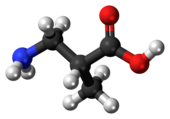
| |

| |
| Names | |
|---|---|
| Preferred IUPAC name
3-Amino-2-methylpropanoic acid | |
| Other names
3-Aminoisobutyrate
| |
| Identifiers | |
3D model (JSmol)
|
|
| ChEBI | |
| ChemSpider | |
| ECHA InfoCard | 100.005.132 |
| KEGG | |
PubChem CID
|
|
| UNII | |
CompTox Dashboard (EPA)
|
|
| |
| |
| Properties | |
| C4H9NO2 | |
| Molar mass | 103.12 g/mol |
Except where otherwise noted, data are given for materials in their standard state (at 25 °C [77 °F], 100 kPa).
| |
3-Aminoisobutyric acid (also known as β-aminoisobutyric acid or BAIBA) is a product formed by the catabolism of thymine.
During exercise, the increase of PGC-1α protein triggers the secretion of BAIBA from exercising muscles to blood (concentration 2 to 3 μM in human serum). When BAIBA reaches the white fat tissue, it activates the expression of thermogenic genes via PPARα receptors, resulting in a browning of white fat cells.[1] One of the consequences of the BAIBA activity is the increase of the background metabolism of the BAIBA target cells.
It is thought to play a number of roles in cell metabolism, how body burns fat and regulates insulin, triglycerides, and total cholesterol.[2][3][4]
BAIBA is found as a normal metabolite of skeletal muscle in 2014. The plasma concentrations are increased in human by exercise. The production is likely a result of enhanced mitochondrial activity as the increase is also observed in the muscle of PGC-1a overexpression mice. BAIBA is proposed as protective factor against metabolic disorder since it can induce brown fat function.[1]
See also[edit]
References[edit]
- ^ a b Roberts LD, Boström P, O'Sullivan JF, Schinzel RT, Lewis GD, Dejam A, et al. (7 January 2014). "β-Aminoisobutyric acid induces browning of white fat and hepatic β-oxidation and is inversely correlated with cardiometabolic risk factors". Cell Metabolism. 19 (1): 96–108. doi:10.1016/j.cmet.2013.12.003. PMC 4017355. PMID 24411942.
- ^ Begriche K, Massart J, Fromenty B (June 2010). "Effects of β-aminoisobutyric acid on leptin production and lipid homeostasis: mechanisms and possible relevance for the prevention of obesity". Fundamental & Clinical Pharmacology. 24 (3): 269–82. doi:10.1111/j.1472-8206.2009.00765.x. PMID 19735301. S2CID 2520238.
- ^ Ibrahim A, Neinast M, Arany ZP (June 2017). "Myobolites: muscle-derived metabolites with paracrine and systemic effects". Current Opinion in Pharmacology. 34: 15–20. doi:10.1016/j.coph.2017.03.007. PMC 5651206. PMID 28441626.
- ^ Tanianskii DA, Jarzebska N, Birkenfeld AL, O'Sullivan JF, Rodionov RN (February 2019). "Beta-Aminoisobutyric Acid as a Novel Regulator of Carbohydrate and Lipid Metabolism". Nutrients. 11 (3): 524. doi:10.3390/nu11030524. PMC 6470580. PMID 30823446.
Well, that’s interesting to know that Psilotum nudum are known as whisk ferns. Psilotum nudum is the commoner species of the two. While the P. flaccidum is a rare species and is found in the tropical islands. Both the species are usually epiphytic in habit and grow upon tree ferns. These species may also be terrestrial and grow in humus or in the crevices of the rocks.
View the detailed Guide of Psilotum nudum: Detailed Study Of Psilotum Nudum (Whisk Fern), Classification, Anatomy, Reproduction